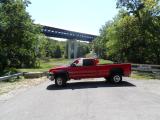- Replies 25
- Views 5.1k
- Created
- Last Reply
Top Posters In This Topic
-
 Mopar1973Man 8 posts
Mopar1973Man 8 posts -
 rancherman 5 posts
rancherman 5 posts -
 diesel4life 4 posts
diesel4life 4 posts -
 Diesel 3 posts
Diesel 3 posts


after searching for a fuel lab to do some home testing.. I found this site.
http://www.johnfjensen.com/Diesel_fuel_additive_test.pdf
It is 7 years old, but had some pretty good info on various additives still on the shelves today.
I always wondered what the hfrr stood for, and in a nut shell, they take a steel ball bearing, and it's rubbed across a steel bar at high frequency for 90 minutes, immersed in the test fuel.
At that time, the ball bearing is microscopically inspected for wear, and the 'scar' is measured in microns.
the actual measurement of the scar is the fuel rating..
I can't cut and paste that page to here, but I promise it's worth taking a look at!
our wally world 2 stoke was in the game @ 474 score... but only tested at 1:200 ratio! sidebar: NOT ULSD COMPLIANT, MAY DAMAGE 2007 SYSTEMS. wth? are they talking about the duramaxes and their optic eye in the fuel system??
anyhoo, #1 with a hfrr score of 221 is the SOYPOWER bio diesel blended at 50:1 with 'normal' fuel.
My beloved theory of running weo fell short!
They used Shell Rotella 15w40 at 200:1 ratio, with only a score of 634... only slightly better than the baseline fuel. almost a statistically insignificant amount. Sidebar: not ulsd compliant.
I'd like to blend some various amounts and send off to be tested of my recipe!
maybe the Rotella is the problem??